13.1 Stress and Strain
Plate collisions and the accumulated weight of overlying rocks exert forces on rocks at depth. While the size of the force is important, it also matters whether the force is distributed over a wide region, or tightly focused on a small area. The same force will have a greater effect when acting over a small area than when acting over a larger area. If you have ever used snowshoes to walk across a snow bank without sinking in, you have taken advantage of the effects of distributing force (your mass acted upon by gravity) over a wider area (the area of your snowshoes rather than the soles of your boots). Stress is force adjusted for the area over which it is distributed. Strain is the change in shape that happens when rocks are deformed by stress.
Types of Stress
Stresses fall into two categories: normal stress acts at right angles to a surface, and shear stress acts parallel to a surface (Figure 13.2). Normal stress is subdivided into compression, when the stresses are squeezing a rock, and tension, when stress is pulling it apart. Rocks undergo compression in regions where plates are colliding, or where they are being buried beneath other rocks. Rocks experience tension where divergence is happening, such as when a continent is beginning the rifting process. Shear stress is characteristic of transform plate boundaries, where plates are moving side by side.
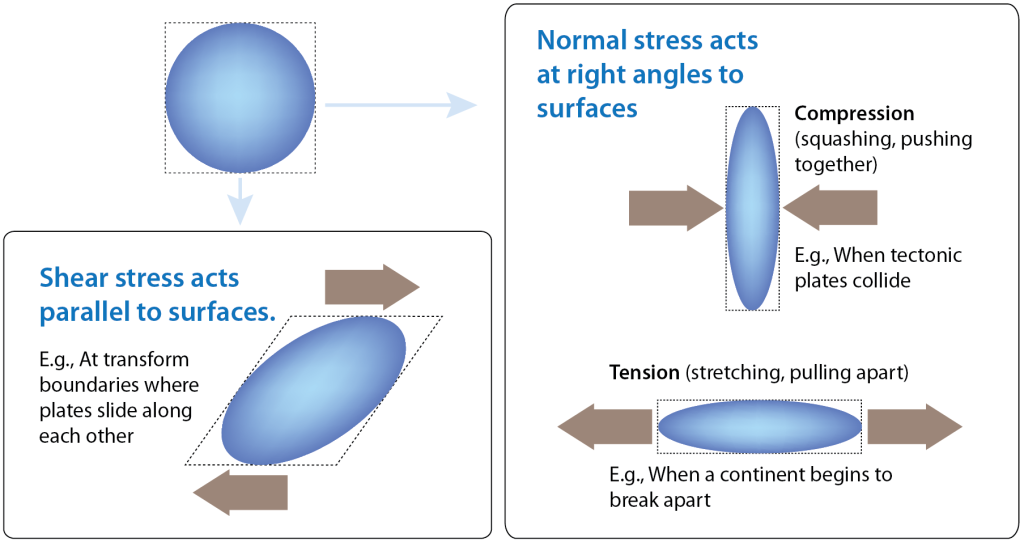
Although Figure 13.2 shows only one set of stress arrows for each scenario, rocks within the Earth are subject to stress from all directions. The relative size of the stresses in different directions will determine the response of the rock. Consider a deeply buried rock being stretched as a continent breaks apart (Figure 13.3). It is also being compressed by the weight of overlying sediments and rocks, but the stress from compression is relatively small compared to the tension from rifting. The net effect of stress acting on the rock will be determined more by the tension from rifting than by the compression from overlying rocks.
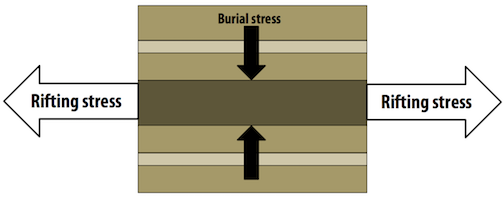
Rocks experience stress from all directions, but it is possible to break down stresses into three directions, just like a graph with x, y, and z axes. In diagrams showing these three directions, the sizes of arrows representing each direction will indicate the relative size of stresses, as they do in Figure 13.3. Analyzing stress in this way makes it much easier to describe the stresses operating on a rock, and to understand what their net effect will be.
Types of Strain
How a rock responds to stress depends on many factors. The “how” is not simply a matter of how much strain a rock will undergo, but what type of strain will occur. Is the deformation permanent or temporary? Does the rock break or does it deform without breaking?
Elastic Strain
Elastic strain is reversible strain. You can think of elastic strain as what happens to the elastic waistband of your favourite sweatpants when you put them on. The elastic stretches to let you into your pants, and once you’re in them, it shrinks to keep them from falling down. When you take the pants off again, the elastic goes back to its original shape. Similarly, rocks undergoing elastic strain will snap back to their original shape once the stress is removed. Rocks snapping back to their original shape undergo elastic rebound. Elastic rebound of rocks on a large scale can have profound consequences, because the energy released causes the Earth to vibrate. We experience those vibrations as earthquakes.
Plastic Strain
If enough stress is applied, the changes that a material undergoes to accommodate the stress will leave it permanently deformed. When the stress is removed, the material does not go back to its original shape. The permanent deformation is called plastic strain.
Ductile or Brittle?
Ductile deformation refers to deformation that happens by flowing or stretching. The marble monument in Figure 13.4 is undergoing ductile deformation as it sags beneath its own weight.
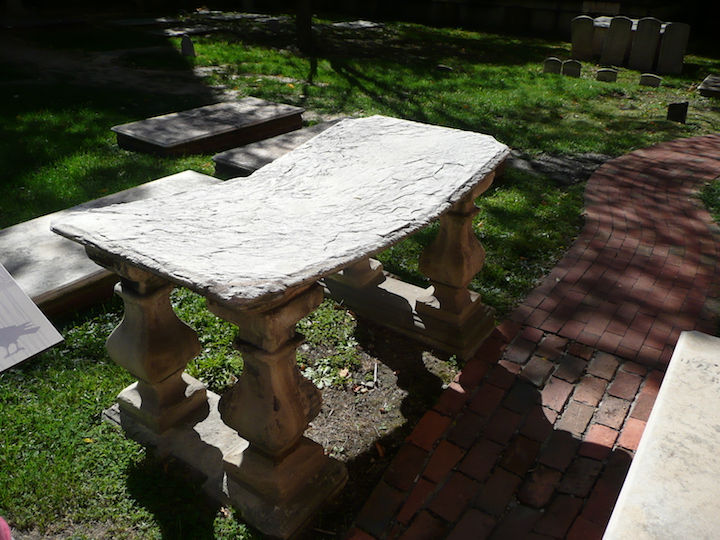
When a material breaks, it has undergone brittle deformation (Figure 13.5). The stone cylinders in Figure 13.5 are part of an experiment to test the strength of the rock. The cylinder on the right looked like the cylinder on the left before it was compressed, with force applied to the top and bottom. Strain gauges have been glued on to measure the amount of deformation lengthwise and across the cylinders.
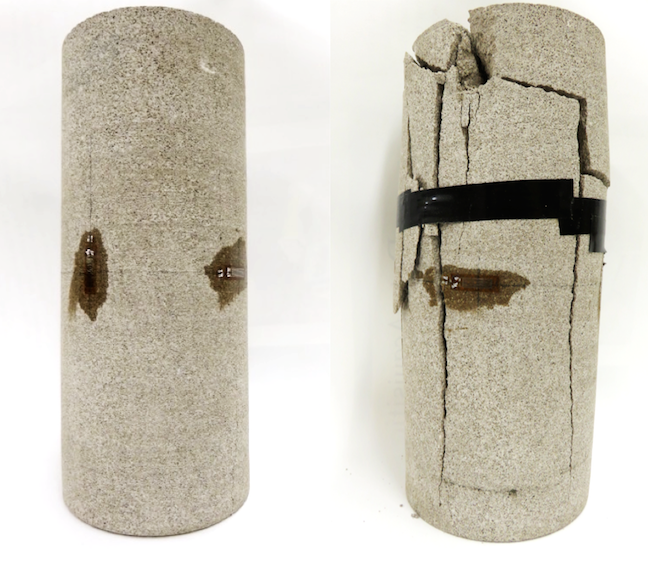
A material can undergo more than one kind of deformation when stress is applied. The barrel-shaped cylinder of potash in Figure 13.6 (right) originally looked like the cylinder on the left. The cylinder was compressed, with stress applied from the top and bottom. Initially, it underwent ductile deformation and thickened in the middle, creating the barrel shape. But as more stress was applied, the cylinder eventually underwent brittle deformation, resulting in the crack across the middle.

Factors That Determine How A Rock Will Deform
A rock is not limited to exclusively brittle deformation, or exclusively ductile deformation. Even the deformed rock in Figure 13.5, which has clearly undergone brittle deformation, shows a slight curvature on the right side, near the top. This indicates that a small amount of ductile deformation occurred before brittle failure.
For a given rock, deformation will be different depending on the amount of stress applied. Up to a point, rocks undergo elastic deformation, and will spring back to their original shape after the stress is removed. If more stress is applied, the rock may deform in a ductile manner. If stress increases further, the rock may fracture. The amount of stress required in each case will depend on the type of rock, as well as conditions such as pressure and temperature.
Composition
In general, sedimentary rocks will be more likely to undergo ductile deformation than igneous or metamorphic rocks under the same conditions. Rocks within each group will also deform differently.
Boudinage structures (Figure 13.7) highlight the effect of composition on how rocks deform. These structures occur when a stronger rock more prone to brittle deformation is surrounded by weaker rocks prone to ductile deformation. The stronger rock will fracture into segments, called boudins, and the weaker rock will flow into the spaces between. In Figure 13.7 (top), the white layer reached the stage of pinching off, just before separating into segments. The surrounding black layer flowed in to fill the gap where the pinch was happening. Remarkably, the white layer itself contains a dark layer that has fragmented into boudins. Not all boudins break into blocky segments. Some display more ductile deformation (Figure 13.7, bottom).

Temperature and Pressure
At higher temperatures, and under higher confining pressures, rocks are more likely to undergo ductile deformation. Confining pressure is the stress that a material experiences uniformly from all sides as a result of the weight of material above and around it. The pressure that a diver feels deep in the ocean is confining pressure due to the weight of water above and around the diver. This kind of confining pressure is called hydrostatic pressure. Within Earth, the confining pressure is due to the weight of overlying rocks. Confining pressure due to the weight of rocks is called lithostatic pressure.
The rocks in Figures 13.5 and 13.6 experienced confining pressure from the atmosphere, and temperatures comfortable for the humans working in the lab. Under those conditions the rocks ultimately underwent brittle failure when they were compressed in the lab. Deep within the crust, the temperatures and confining pressures are far greater. Deep enough within the crust, both samples would undergo only ductile deformation if the same amount of stress were applied as in the experiment. The depth at which temperatures and confining pressures are high enough for rocks to go from brittle deformation to ductile deformation is called the brittle-ductile transition zone.
The brittle-ductile transition zone occurs between approximately 10 km and 30 km depth, corresponding to temperatures around 300 ºC and greater. The depth at which temperatures reach 300 ºC at any particular location will depend on heat flow at that location. In continental crust, rocks at 300 ºC are deeper than in ocean crust. The change in pressure with depth also varies, depending on the mass and density of rocks. If depths are measured relative to sea level, the pressure at 10 km measured beneath a tall mountain belt will be greater than the pressure at 10 km measured within ocean crust.
Experiments like those shown in Figures 13.5 and 13.6 can be used to determine where the brittle-ductile transition zone will be for a particular rock type. Experimenters apply stress to sample of a rock for a range of temperatures and confining pressures. They note the conditions under which the rock breaks or deforms in a ductile manner, and plot those on a graph (Figure 13.8). The results in Figure 13.8 are from experiments on limestone. The vertical axis is pressure. The more pressure, the deeper the rock would have to be within the Earth to experience that pressure. The white line represents the brittle-ductile transition zone. Above the white line are pressures and temperatures under which the limestone would fracture. Below the white line in the tan area are pressures and temperatures where the limestone would deform by flowing. Notice that the higher the temperatures, the less confining pressure is required for ductile deformation.
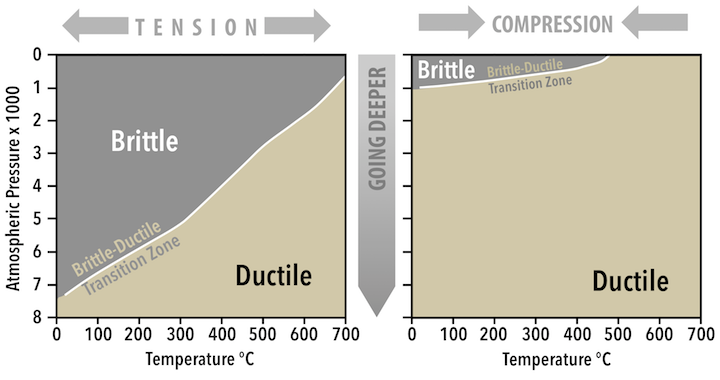
How Stress Is Applied
The limestone experiments were performed by applying stress as tension (Figure 13.8 left) and again by applying stress as compression (right). When tension was applied, temperature and confining pressure had to be much higher before ductile deformation occurred. Under compression, ductile deformation was possible with far less confining pressure, and at lower temperatures.
Strain rate, the rate at which deformation occurs, also makes a difference. If stress is applied at a rate that causes rapid deformation, the rock will be more likely to fracture than if deformation happens slowly. The marble slab in Figure 13.4 is a good example of this. It has sagged rather than broken because the rate of deformation has been very slow, at millimetres per decade.
Fluids
When rocks are under pressure, fluids trapped within the pore spaces of rocks- the gaps between grains- are also under pressure. Higher confining pressure is required for deformation to be ductile rather than brittle, but pressure from fluids, called pore pressure, resists the confining pressure. The result is that the effective confining pressure is lower than it would be without the fluids. Depending on the amount of pore pressure, and how close the rock is to the brittle-ductile transition zone, pore pressure could cause brittle failure in a rock that would otherwise undergo ductile deformation.
Stress and Geological Structures
Many different geologic structures can form when stress is applied to rocks. Structures form as a result of fracturing, tilting, folding, stretching, and squeezing (Figure 13.9). Some structures, like the fractures that make basalt columns (Figure 13.9, upper left), happen when rocks shrink due to cooling, but others are a consequence of plate tectonic forces. The types of structures that form depend on the plate tectonic setting and other geological conditions, making them valuable tools for understanding what happened to the rocks. The following sections address the different kinds of structures that form, and what information we can gather from these structures to learn more about the tectonic environment and regional geology.
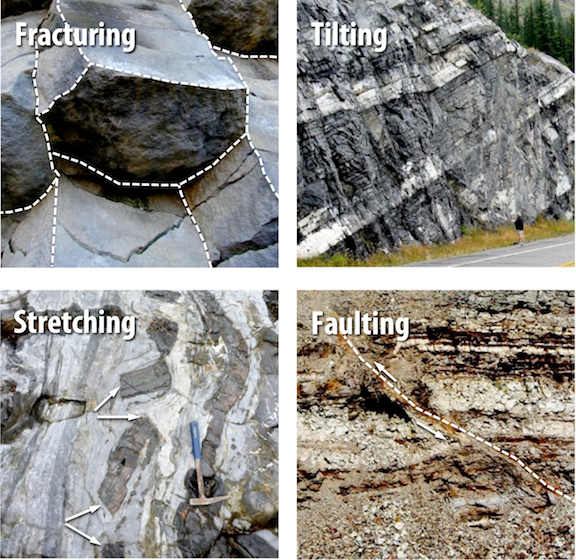
References
Heard, H. C. (1960). Transition from Brittle Fracture to Ductile Flow in Solenhofen Limestone as a Function of Temperature, Confining Pressure, and Interstitial Fluid Pressure. In D. Griggs & D. Handin (Eds.), Rock Deformation (A Symposium): Geological Society of America Memoir 79 (pp. 193-226). https://doi.org/10.1130/MEM79

